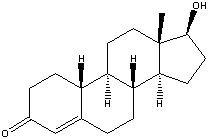 While athletes warm up for that great event, those less than scrupulous participants who try to improve their performance with a dose of the steroid nandrolone better watch out. British scientists have come up with an inexpensive and easy technique that can detect minute quantities of nandrolone in a sample.
While athletes warm up for that great event, those less than scrupulous participants who try to improve their performance with a dose of the steroid nandrolone better watch out. British scientists have come up with an inexpensive and easy technique that can detect minute quantities of nandrolone in a sample.The nandrolone (chemical structure shown) detector has been built by Carl Percival and his team of physicists and chemists at Nottingham Trent University. It can detect the tiniest quantities of nandrolone in a liquid sample down to tens of parts per billion.
Anabolic steroids, look and work like the male hormone testosterone. Sports authorities ban them because they give the user more than a sporting chance by artificially helping them boost muscle strength and cut down recovery times after strenuous training.
It is not only the integrity of sporting events that are at risk when athletes use steroids, they also put their own long-term health at risk. Steroid abuse has been linked to the development of inappropriate secondary sex characteristics, such as breast growth in men, who may also suffer impotence because of abuse. Women abusers sometimes develop masculine facial hair and suffer baldness. Moreover, steroids have been linked with liver damage, heart disorders and even cancer.
According to Percival, a quick and effective way of screening many samples for anabolic steroids, such as nandrolone, is needed to help stamp out steroid abuse in sport. He and his team reckon that, when fully developed, their device could do the trick. The secret to the device's sensitivity is a tiny piece of polymer into which is imprinted the three-dimensional shape of the nandrolone molecule. When the polymer is exposed to a solution containing nandrolone, the nandrolone molecules slot neatly into the imprinted holes and stick to the polymer.
But, the molecules are obviously far too small for the eye to see, so the researchers use a clever piece of microscale engineering to find out whether the holes are filled or not.
The second component of the detector, exploits the same principle that keeps a quartz watch running on time. It consists of a tiny vibrating quartz crystal on to which the imprinted polymer is fixed during the fabrication process. Detection then involves measuring the frequency of vibration. As nandrolone molecules stick to the imprinted polymer, the mass on the vibrating crystal increases and slows the vibration. The decrease is only small, just a couple of parts per million difference in frequency, but that is enough to be picked up by a sensitive electronic detector.
The researchers have used standard solutions of nandrolone to calibrate this change in the vibrational frequency of the quartz crystal with the concentration of the steroid in the solution. They have compared the test results with a blank detector that had a polymer coating without the nandrolone imprint. There was no frequency change for the blank device in nandrolone solution.
Percival and his colleagues published more details of their nandrolone detector in the journal The Analyst. "We have not got to the stage of testing on 'real' (i.e. urine) samples or developing the hardware for making it a small hand-held device. We have, however, provided a proof of principle," explains team member Mike Newton.
The device will eventually be used in screening, which tells you that "something" is present above a certain amount but cannot reveal the precise quantity, measuring actual concentration requires a much more detailed and expensive analysis. "Screening should provide an instant test to highlight which sample to send to a lab for further analysis and which should be regarded as clean," adds Newton. A patent is pending on the device and the team is now seeking a commercial partner.